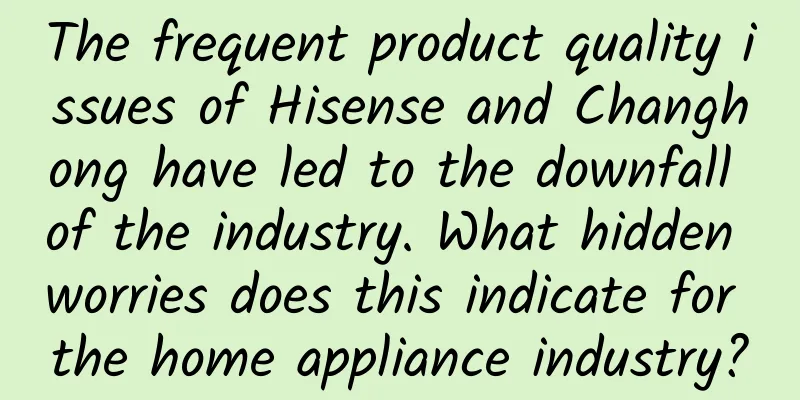The frequent product quality issues of Hisense and Changhong have led to the downfall of the industry. What hidden worries does this indicate for the home appliance industry?

|
This year, China's home appliance market is gradually recovering from its lows due to the influence of macroeconomic regulation and other factors. According to the latest data released by the Ministry of Industry and Information Technology, in the first four months of 2017, the main business income of the home appliance industry was 493.76 billion yuan, a cumulative year-on-year increase of 15.3%; the total profit was 29.03 billion yuan, a cumulative year-on-year increase of 7.9%. It can be seen that it is precisely because home appliance companies have continued to focus on supply-side reform, strengthen technological innovation and product structure adjustment that the process of industry standardization, branding and intensification has been promoted, achieving stable growth in revenue in the first quarter. However, in contrast to the gradually formalized development of black and white home appliances, today's small home appliance market is showing a trend of "wild growth". Not only have quality problems been exposed one after another, but even after-sales service has also seen the phenomenon of impersonation. Quality problems frequently occur in small household appliances, and even famous brand products are not immune Earlier this month, the Shanghai Quality and Technical Supervision Bureau disclosed the results of the 2017 Shanghai air purifier product quality supervision spot check. 27 batches of products were spot checked, and 24 batches were qualified after inspection. Three batches of air purifier products from Hisense, Changhong and others failed the particle cumulative purification volume test. Subsequently, the Shaanxi Quality and Technical Supervision Bureau also randomly inspected 11 batches of air purifier products. According to the random inspection, 5 batches of products from 11 distributors, including Panasonic and Hitachi, did not meet the national standards, involving the standby power, clean air volume, purification efficiency, and noise of the air purifiers. However, no one could have imagined that the "quality gate" of air purifiers would become the beginning of centralized inspections of small household appliances. Later, according to the investigation results released by the Guangdong Provincial Quality and Technical Supervision Bureau, in the quality inspection of 100 batches of induction cooker products on the market, 48 batches of products produced by 44 companies failed to meet the quality standards, and the detection rate of unqualified products reached 48%. It is worth noting that the list of unqualified products in the quality inspection also includes old brands such as Triangle and Hemisphere. Many products of these brands have mechanical strength failures and abnormal operations. Are small home appliance problems just a small gap? What really affects is reputation and credibility In fact, in the past 30 years, not only foreign brands of home appliances, but also domestic brands in the small home appliance industry have achieved a significant improvement in their overall manufacturing level. Data shows that a large number of foreign brands have outsourced their products to Chinese companies for manufacturing in the past 10 years, including high-end foreign brands such as Japan's Tiger and South Korea's Fuku rice cookers. It is very unfortunate that in recent times, a series of industry product problems have continued to emerge, resulting in the rising trend of market recognition of these home appliance brands not being proportional to their attitude towards product quality. This may be because some home appliance brands do not pay enough attention to small home appliances, and the problem of small home appliances with insufficient high-end pricing is only seen as a small gap in the brand. But fundamentally speaking, even if the quality problems of small household appliances are characterized by manufacturers as minor flaws, the impact on the brand reputation and credibility is no different from that of other categories. In particular, the scope of this issue also involves Japanese manufacturers such as Panasonic and Hitachi, which were once labeled as having high-quality products, as well as domestic home appliance leaders such as Hisense and Changhong, which is enough to attract more attention and reflection from the industry and consumers. As a winner of Toutiao's Qingyun Plan and Baijiahao's Bai+ Plan, the 2019 Baidu Digital Author of the Year, the Baijiahao's Most Popular Author in the Technology Field, the 2019 Sogou Technology and Culture Author, and the 2021 Baijiahao Quarterly Influential Creator, he has won many awards, including the 2013 Sohu Best Industry Media Person, the 2015 China New Media Entrepreneurship Competition Beijing Third Place, the 2015 Guangmang Experience Award, the 2015 China New Media Entrepreneurship Competition Finals Third Place, and the 2018 Baidu Dynamic Annual Powerful Celebrity. |
<<: Qiantu K50 rolls off the production line, Lu Qun's "Dragonfly" finally takes off
Recommend
The iPhone 6S only has 2GB! Is it true that more memory is better for a mobile phone?
Since last year, 4G RAM capacity has gradually bec...
Elephants and whales have so many cells, why are they less likely to get cancer?
Produced by: Science Popularization China Author:...
Will the quarantine costs for college students in Shanghai returning home be free in 2022? Attached are the latest policies from various places!
At present, all 16 districts in Shanghai have ach...
Zhong Nanshan's latest prediction! The second wave of COVID-19 may peak at the end of June!
On the morning of May 22, at the Biomedicine and ...
Finally saw the "iron tree" bloom! There are only 5 wild plants left in the world. The "Tianmu Iron Tree" looks like this...
Hey, look up, I'm here! Hello everyone, I am ...
The latest news on express delivery during the Shanghai epidemic in 2022: Can it be sent and received normally? When will things return to normal?
As a pioneer in receiving international personnel...
Analyze these 4 factors of the viral growth model
What is Growth Hacking ? This concept originated ...
The Dragon Boat Festival is here again, and this is how brands leverage their marketing efforts!
Let me ask you a serious question first: Have you...
A new species 150 million years old has been discovered! The "Zhenghe version of Jurassic World" is here
China is the country with the richest dinosaur sp...
Deliciousness and virtue coexist, the ancients' "chicken on the tip of the tongue" actually has so many meanings!
my country is one of the earliest countries to do...
You can make money by donating your shit, and earn a high-end mobile phone every month. How much money can your poop get you?
Some time ago, a piece of news like this became a...
"Lice" have coexisted with us for tens of millions of years, so why haven't we seen them in recent years?
When talking about lice, everyone may feel their ...
How to provide early warning for user churn?
Recalling lost users is ineffective? The attritio...
Free as a fish! All humans need to survive in the ocean is a gill?
Your browser does not support the video tag Autho...
What is the legendary "absolute zero"?
Absolute zero is a concept that has intrigued cou...









